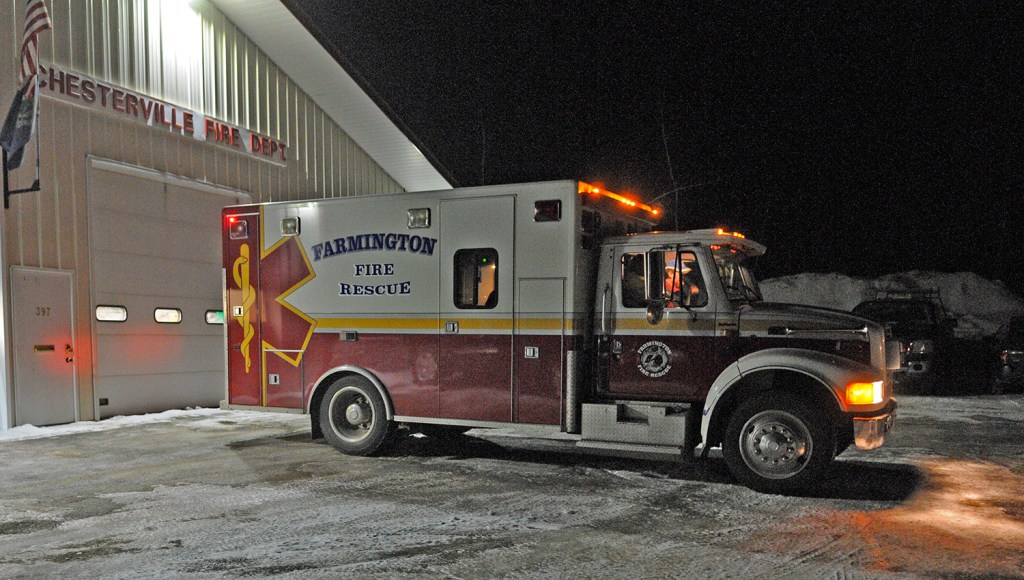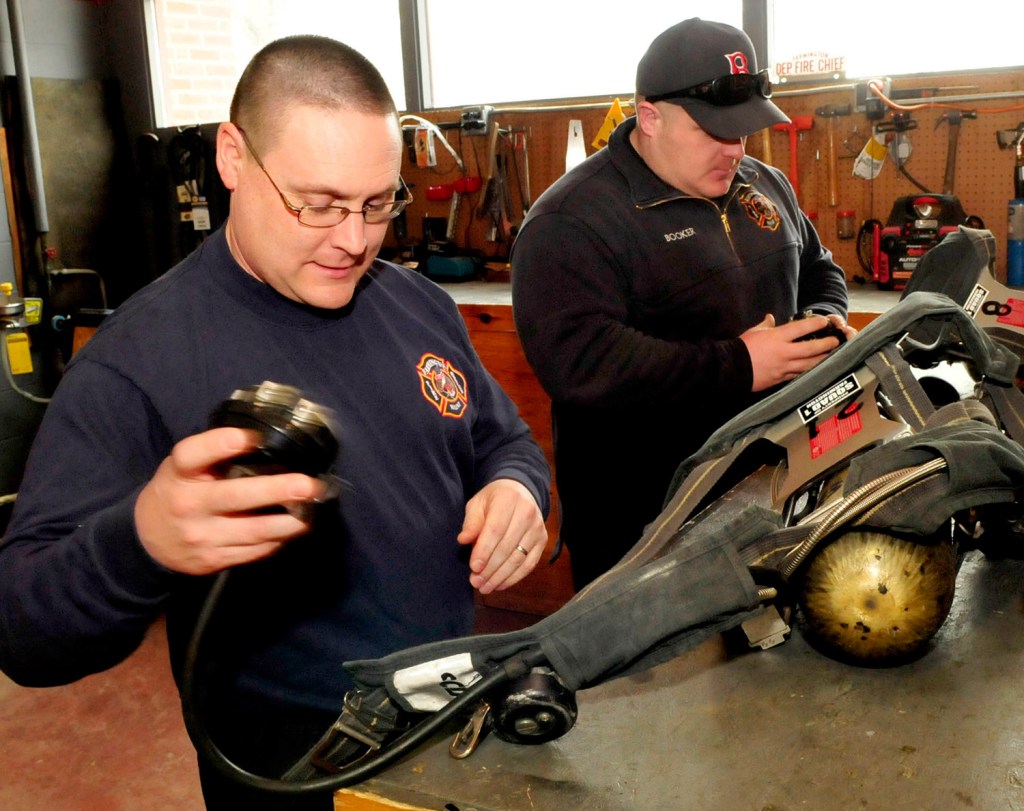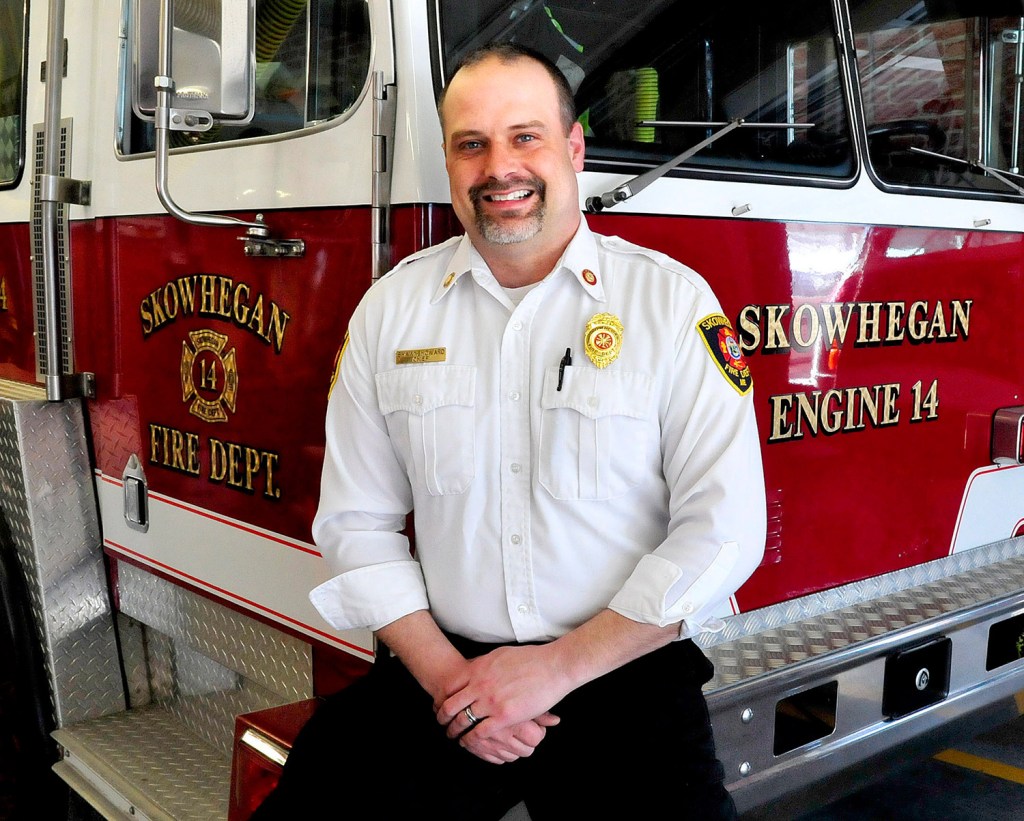Only four firefighters on the China Village Fire Department are trained to enter a burning building. The department needs at least six to launch an interior attack to put out a fire.
When Fire Chief Tim Theriault looks at his roster of 22 volunteers, he sees only four under the age of 50; he had 15 or more volunteers under age 50 a decade ago. Some on the roster now are in poor health. Others, between jobs and family, have no time for the additional training they need.
And many of the volunteers, while willing, aren’t able.
“I got guys who are claustrophobic,” Theriault said. “They can’t put a mask on. But you don’t want to throw them away, because they are willing to help.”
The result: The department may not get enough manpower on scene to knock down a fire before the entire structure is lost while waiting for mutual aid assistance from other town departments.
It’s a challenge facing small fire departments across Maine: They can’t slow the steady decline in residents who volunteer to fight fires, and they can’t afford full-time staff. At the same time, a decline in state revenue sharing and fewer 9/11-inspired grants have tightened municipal budgets, while the demand for fire and rescue services is increasing.
The problem is threatening communities’ very ability to offer an essential public service.
The Madison and Skowhegan departments have struggled in recent years to maintain a roster of 22 volunteer firefighters in addition to eight who are full-time, said Chief Shawn Howard, who leads both departments. Two or three decades ago, there were waiting lists for the volunteer roster.
Firefighters are also performing more services, such as emergency medicine for the state’s aging population. All the while, the firefighters are aging, too.
“The public is looking for firefighters to do more with less,” said Clyde Ross, 78, the Farmington Fire Department’s deputy chief. “And the worst part is, we’ve accepted that.”
The clash of increased demand with fewer available staff is not at a crisis level in central Maine – yet.
“We’re heading in that direction if we don’t see a change,” said Ken Desmond, president of the Maine State Federation of Firefighters. “That’s why we’re trying to do something before it gets to that point.”
GROWING COSTS ADD TO CHALLENGES
For the first time in 28 years, the majority of volunteer firefighters in the United States are over age 50, according to a firefighter profile released in November by the National Fire Protection Association.
At the same time, the cost of fighting fires is growing steadily. In 1980, U.S. municipalities spent $5.7 billion on fire services, the association said. In 2011, the latest data available, municipalities spent $42 billion on fire protection services. Even adjusted for inflation, the cost of firefighting services has more than doubled since 1980.
Volunteers, or on-call firefighters, make up 70 percent of the U.S. fire service; in Maine, 93 percent of fire departments are either entirely or primarily staffed by volunteers, according to the Maine State Federation of Firefighters.
Volunteers often get a stipend or wage, but departments are finding that the money they offer isn’t enough. Maine had 12,000 firefighters in the early 1990s, Desmond said, but the number has dropped to “at best, 8,000.”
Fire officials across the region say shifting social patterns are to blame for the lack of interest in becoming a volunteer firefighter. People work long hours away from their town and can’t respond to day calls.
Farmington’s Ross said he sees a general decline in interest in civic involvement.
“This did not happen overnight. This has taken a generation to work on,” said Ross, who is a member of the town budget committee, Masons, Farmington Village Corporation, Franklin County Emergency Management Agency and Franklin County Firefighters Association. “I don’t think the younger generation wants to get involved.”
Theriault said older firefighters talk about feeling like they can’t leave their departments because they know the town’s needs and know there’s no one to replace them. Also a licensed emergency medical technician, Theriault has been on the China department for 28 years.
“We’re an aging bunch of old people, and it’s not good,” said Theriault, who is also District 79’s state representative. “I cannot seem to recruit any young people for any reason whatsoever. Everyone is too busy.”
Perceptions that fire departments are “a good old boys club” don’t help, Theriault said.
Nationwide, 3.4 percent of firefighters in 2012 were women, according to the latest data available by the National Fire Protection Association. While female firefighters are scattered throughout Maine’s departments, Farmington Fire Chief Terry Bell said, there doesn’t seem to be much interest from women. A recently formed group called Female Firefighters of Maine is trying to encourage women in firefighting.
Joseph Hastings, 19, a lieutenant with the Chesterville Fire Department, said he understands that the time commitment is more than what many younger people can or want to deal with. He’s also a member of the Farmington Fire Department and attends training or meetings every Tuesday.
“I haven’t had a free Tuesday night in over a year and a half,” he said.
‘CAN’T AFFORD NOT TO HAVE’ TRAINING
The amount of training required to be a firefighter has increased over the years, a reflection of the greater role that departments play in emergency and rescue services, changes in the science of fighting fires, changes in fire safety equipment and knowledge, and a change in how fires themselves burn.
Firefighters need to respond to fires in a shorter amount of time these days because modern furnishings are often petroleum-based and burn hotter and faster than they did even a couple of decades ago. A fire that might have consumed a room in 20 minutes in the recent past would now spread through that same room in about 3½ minutes, said Bill Guindon of the Brunswick-based Maine Fire Service Institute, which directs training for the state’s fire departments.
There’s other training, too. The Skowhegan and Madison fire departments have been trained to recognize methamphetamine labs. After 2001, terrorism awareness training was introduced and departments started to teach WMD – or weapons of mass destruction – and bomb awareness. Special teams train for ice water rescue in towns with lakes and rivers. If a natural gas pipeline runs through town, firefighters must train for gas emergencies.
Small-town fire chiefs say the time-consuming training strains firefighters and turns off new recruits.
“It’s all in the good nature of safety,” Theriault said. “For a full-time fire department? Great. They can handle any kind of regulation you put in front of them because they go full time. Volunteer fire departments don’t have the time.”
Phillips Town Manager Elaine Hubbard pointed out that the training required in her northern Franklin County town of 1,028 is the same required in Bangor, with 30,000 residents and a full-time fire department. Hubbard said the town can’t keep up with the increasing mandates and training.
“We can’t afford it, but we can’t afford not to have it,” she said.
Guindon, who got into firefighting 37 years ago, said firefighters used to learn informally and as fires happened. It wasn’t standard to wear oxygen masks, for instance.
“When most of us started out, it was just, ‘Follow me, and we’ll show you the ropes,’ ” he said.
Firefighters know more today about how to be properly protected on the road, about what type of safety gear is appropriate and what kind of hazards they could encounter.
“Part of the reason for the changes is that we’ve learned how to be safer,” Guindon said.
FOR EACH TOWN, IT’S A BALANCING ACT
How much the volunteer firefighters “volunteer” their time varies widely. It’s a balancing act as each town determines how much it can afford compared to how little can be offered and still lure people to do the job.
Strong, a town of 1,200, and China are among the few towns that don’t pay firefighters at all.
Many of the bigger towns have a full-time chief, but the rest of the crew is volunteer.
Chesterville, like the majority of towns with on-call firefighters, compensates firefighters to some extent. Chesterville firefighters get a lump sum for each quarter, which is divided among those who went on calls that pay period. It usually adds up to a little less than minimum wage.
When Hastings got his first Chesterville check, he was surprised. He wasn’t expecting it. He’s aware he is one of the few recruits who felt that way about the pay.
“We’re kind of going through a struggle. We don’t have enough people because of that reason,” he said. “It’s getting to the point where people want money.”
In Farmington, voters agreed last year to increase the number of per-diem firefighters to a rotating list of two or three firefighters at a time, who work shifts during the day, seven days a week. Starting compensation for per-diem firefighters in Farmington is $8.50 an hour, with no benefits.
Bell said scheduled paid firefighters are in part needed because it’s hard to ask people to leave their jobs for a call.
“It’s a commitment,” he said. “Years ago, when you had 100 calls, they could give a little bit of time to it.” Last year Farmington had 405 calls.
China has a population of 4,100 and three fire departments with three chiefs who each have their own budgets but provide mutual aid to one another. The town pays a total of $65,000 for the three departments. It pays $85,000 for a separate rescue department, which is also staffed by volunteers.
Neighboring Benton, with a population of 3,000, doesn’t have a fire department but contracts with Fairfield’s full-time department for $165,000 a year.
Whatever the amount appropriated for departments in town budgets, it has to be buffered with grants, donations and fundraising, such as bean or spaghetti suppers. China gets money for daily operations but has to raise money for things like truck purchases.
“When’s the last time you saw a police department holding a bake sale?” Farmington’s Ross said.
Communities without fire departments may pay in other ways. Caratunk, in Somerset County, used to have a volunteer department, Selectwomman Liz Caruso said, but it didn’t by the time she took office in 2006. The town’s population in the 2010 census was 69, and town officials say the year-round population is closer to 40.
In November, it took volunteers from Bingham, Solon, West Forks and Jackman nearly half an hour to get enough volunteers to a fire in Caratunk to begin fighting it, and by then it was too late to save the two buildings, which burned to the ground.
EFFORTS IN THE LEGISLATURE
If solutions aren’t found for the problems, firefighters say, the shrinking number of on-call members means people and property will be put at risk.
Fire officials cite a fire in Bridgton in February in which only three people responded in the first 30 minutes and the house was destroyed. The deputy chief told WCSH-TV Channel 6 that the fire could have been knocked down in five minutes but took more than a half-hour because there weren’t enough firefighters for an interior attack.
Desmond, of the Maine State Federation of Firefighters, said selectmen and town councilors worry that this will happen more frequently. His organization is due to hear soon on a federal American Fire Act grant for all the New England states that would pay to train as many as 100 firefighters per state.
The Maine State Federation of Firefighters lobbied last legislative session for a financial rewards program for those with longevity in a volunteer department. The Legislature passed it, but Gov. Paul LePage vetoed it. In his veto message, LePage said the program was well-intentioned but financially unwise, and said it “expands state government at a time when the taxpayers of Maine can least afford it.” The federation is lobbying again this year for the legislation, which calls for the state to put money into retirement accounts for volunteer firefighters; it would cost about $300,000 to $400,000 a year, said Bill Vickerson, legislative representative for the federation.
Theriault, a Republican, is co-sponsoring two bills that would ease the financial regulations on smaller fire departments. One bill would allow tax increment financing money, normally reserved for business development, to be used for emergency services such as fire departments. The other would allow towns to pay up to $750 to volunteer firefighters who don’t get other compensation.
“I’m throwing darts at the board, seeing if something sticks,” Theriault said. “We have to try something.”
PRESSURE TO REGIONALIZE
Increasing taxes to pay for more career firefighters could be the only option many towns will be left with if more residents don’t volunteer, Ross said.
Some communities are considering regionalization, but that isn’t an easy sell. Other efforts to regionalize over the past decade, most notably with school districts and county jails, have failed to contain costs while ceding local control.
Hubbard, of Phillips, said she is not a fan of regionalizing fire services, but there is mounting pressure to do so. “It may come to the point where (we) might have to,” she said.
Other Franklin County fire departments have been meeting to discuss consolidating and recently made a combined purchase of gear. The departments also share personnel – for instance, Farmington’s Kyle Ellis is deputy chief of the Wilton department and Mike Booker is chief in nearby Jay.
Howard, the chief in Skowhegan and Madison, whose departments are working to share services, said the challenge is keeping up morale by not forcing integration on firefighters.
“The No. 1 asset we have is the firefighters themselves,” Howard said. “They take pride in their department; they take ownership in their department. One of the risks you have is people feeling like they are losing that individuality. I don’t want to take that away.”
In tiny Caratunk, which depends on other towns to fight its fires, Selectwoman Caruso stressed that the need for volunteers is essential.
“One thing I will say is that all these volunteer firefighters, they do a tremendous service to all of our rural areas,” she said. “They sacrifice their time. They go through training. They’re there when you call.”
Send questions/comments to the editors.











Success. Please wait for the page to reload. If the page does not reload within 5 seconds, please refresh the page.
Enter your email and password to access comments.
Hi, to comment on stories you must . This profile is in addition to your subscription and website login.
Already have a commenting profile? .
Invalid username/password.
Please check your email to confirm and complete your registration.
Only subscribers are eligible to post comments. Please subscribe or login first for digital access. Here’s why.
Use the form below to reset your password. When you've submitted your account email, we will send an email with a reset code.